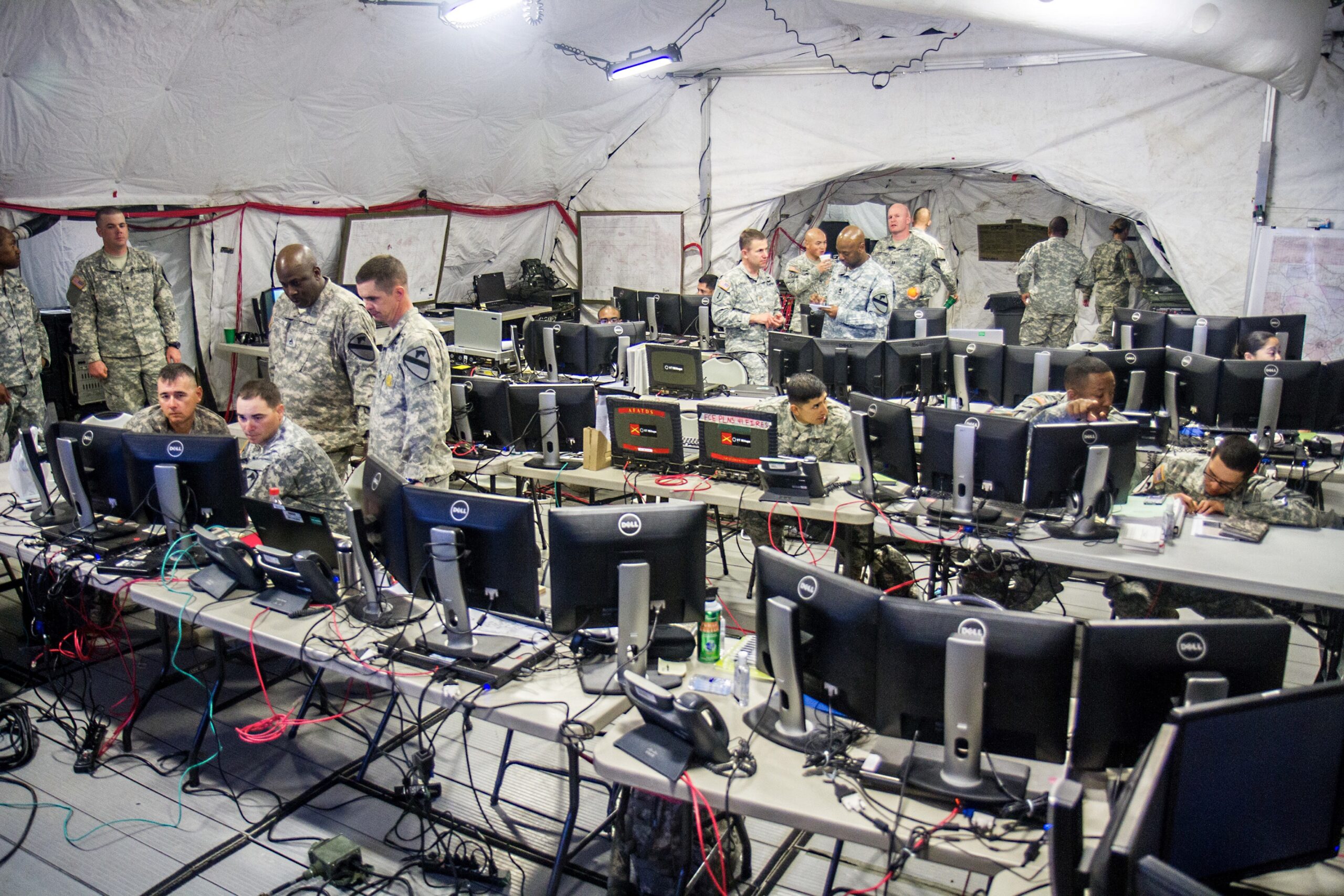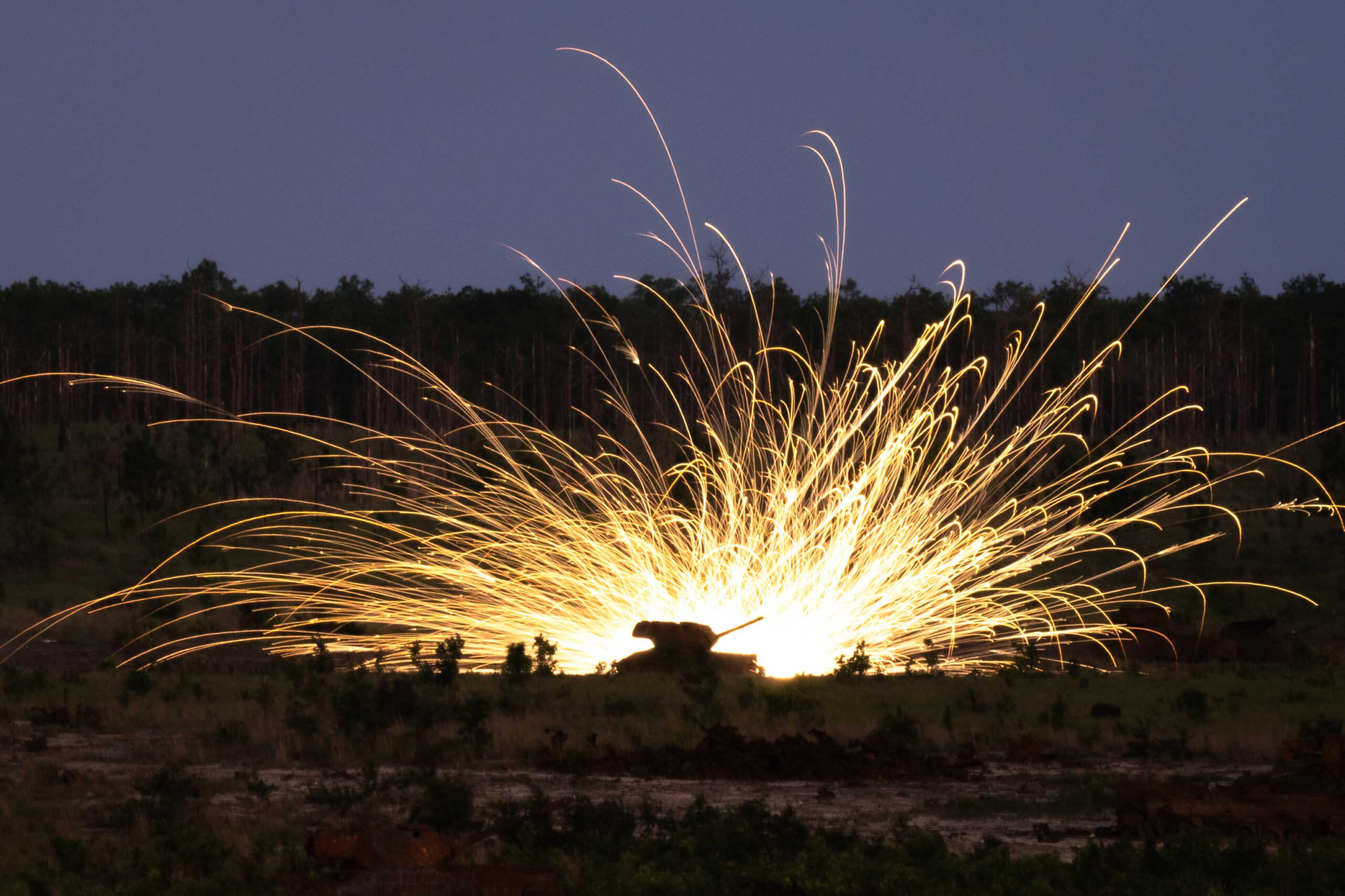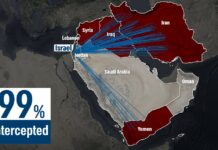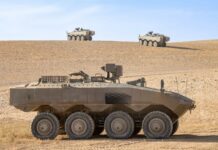Nearly every day, the news from the fighting in Ukraine includes the unmasking, targeting, and destruction of a Russian or Ukrainian tactical Command Post (CP). Imagine what it takes to reconstitute a destroyed brigade or division CP. Numerous generals, hundreds of colonels, and senior operators have been killed in these strikes since the start of the war.
NATO cannot afford to lose CPs the way the Russians and Ukrainians have in the Russia–Ukraine War. Russian CP configurations at the start of the conflict were not much different from NATO’s CPs. Based on these insights, it is vital to rethink how modern military forces prepare their CPs for combat.

Credit: USAF
As the authors of a March 2023 article, ‘The Graveyard of Command Posts,’ in the US Army’s Military Review stated: “We must rethink command posts for this new era of warfare. In the face of this immediate threat … command posts will need to adapt to such an extent that they will be unrecognisable to the generation of leaders that fought in Iraq and Afghanistan.”
NATO’s tactical CPs, as they are currently equipped and operated, are not ready for combat and will not survive the first strike of the next war. Lessons from three recent wars, the Second Nagorno-Karabakh War (2020), the Israel–Hamas War (2021) and the ongoing Russia–Ukraine War (2022-?) demonstrate that CPs are high-value targets and at great risk in the modern battlespace. These recent conflicts are the future of military combat: the Second Nagorno-Karabakh War (2020) was the first war in history won largely through mass employment of robotic systems; the Israel Defence Forces (IDF) declared the 2021 war with Hamas as the first to be won primarily by artificial intelligence; and the Russia–Ukraine War is the largest conflict in Europe since 1945 and employing perhaps the greatest range of military technology in history.
The primary takeaway is that destroying command and control is the essence of 21st century warfare. Today, CPs are nearly impossible to hide and extremely difficult to defend. Finding and targeting a CP is at the top of the enemy’s to-do list. Preparing survivable CP configurations now, and equipping them to win, must be a priority.
Towards a Transparent Battlespace
In the past, the enemy had to be seen and heard with human eyes and ears, and visualised with the use of analogue maps and terrain models. Seeing at night and in extreme weather was particularly difficult. Winning armies undertook extraordinary means to mask their locations; in addition to taking advantage of low night-time visibility, they have made use of environmental conditions including storms and fog, and terrain obscurants such as forests, mountains, and urban terrain. Knowing what was over the next hill, or around the corner in an urban setting required human reconnaissance.
Today, however, a range of sensors are quickly augmenting or in some areas replacing such forms of reconnaissance. Multidomain sensor capabilities, now possessed by even third-tier military powers, have made it much more difficult to hide on the battlefield. Multidomain sensor networks employ technology able to scan from space down to the mud at ground level to reveal targets. Creating an unblinking eye that identifies, locates, and tracks targets in a congested battlespace is not simple. It takes sophisticated planning and systems to reveal the enemy, but it offers a battle-winning advantage and is worth the investment. When ubiquitous sensors are coupled with long-range precision fires, capable of hitting and destroying targets at extreme ranges, staying alive on the modern battlefield can be a challenge.
In the Nagorno-Karabakh War in 2020, Gaza in 2021, and Ukraine from 2022, the combined effort of sensors, drones, and long-range precision fires have shaped the conduct of these conflicts. Seeing enemy forces in the battlespace, and being able to strike them nearly anywhere, is a revolutionary disrupter to traditional methods of warfare. The battlespace is becoming more transparent – a layer of sensors can stream real time information to reveal the battlespace and confirm battle damage, putting every CP potentially at risk. General Mark Milley, the US Chairman of the Joint Chiefs of Staff, stated: “The probability of being seen is very high. In a future battlefield, if you stay in one place for longer than two or three hours, you’ll be dead.” With the rapid acceleration of sensor technology, even two or three hours may be optimistic. Our CP mindset should embrace the concept that there are no longer any safe areas, and we are likely in range of enemy fire. Anything less is inviting disaster.
Reimagining Tactical Command Posts
Command and Control (C2) of military forces and executing mission command is the most important warfighting function. The purpose of a CP is to assist the commander in the execution of Mission Command (MC). MC contends that human decision-making ‘at the point of contact’ generates a flexible and winning approach that fosters harmony, initiative, and speed by understanding the commander’s intent, carrying out mission-type orders, and empowering lower-level initiative. The CP facilitates the commander’s execution of MC by enabling the commander to better understand, visualise, describe, direct, and evaluate combat operations.

Credit: US Army
For decades, tactical CPs have been set up in tents and vans, some elaborate enough to house scores of operators with banks of computers, large display screens and other ancillary equipment. Today, gathering critical, human-brainpower in one location, within range of enemy sensors and fires is a recipe for catastrophe. Tents offer no protection from drones or artillery strikes. Modern alternatives, including CP trailers, called ‘Expando-Vans,’ such as the US Army’s M1087 Expandable Van Shelter, are not much better. Although these vehicles provide an easier CP set-up, they are not truly mobile CPs, as soldiers cannot operate from inside them when they are on the move. These shelters are relocatable, meaning they take time to set up, break down, and move. During an attack by drones, artillery, or missiles, they provide little protection. To improve survivability in the modern battlespace, CPs should be armoured, mobile, masked and dispersed. This is not the traditional CP thinking, but is the harsh reality of modern combat. We must not hesitate in rapidly defining the major design parameters that will prepare a modern CP to meet these requirements.
Armoured: In the Second Nagorno-Karabakh War, Azerbaijan destroyed Armenian tactical CPs in the first weeks of fighting as they were easily discovered and primarily housed in tents and unhardened facilities. In the Israel–Hamas War, the IDF tracked the locations of Hamas leaders and synchronised their attacks with sophisticated, artificial intelligence. As we are witnessing in the Russia–Ukraine War, many Russian CPs have been destroyed by Ukrainian long-range precision fires.
The logical alternative to ‘soft’ cover CPs is to maximise available armoured vehicles for protection from enemy fire. Any armoured vehicle furnished with the necessary Command, Control, Communications, Computers, Intelligence, Surveillance and Reconnaissance (C4ISR) equipment is far superior to a tent or soft-skinned tactical vehicle. Forming a mesh network of mobile, armoured CPs makes the enemy’s reconnaissance and targeting problems more difficult. Each armoured vehicle node must be equipped with the C4ISR systems necessary to independently take over the fight.
In 1982, US Army Gen. Donn A. Starry said, “… experience convinced us that the Corps battle cannot be fought from the Main CP and we believe the evidence is sufficiently compelling for us to field an armour-protected TAC CP [tactical command post] with sufficient equipment and personnel to track the battle and issue timely orders.” His insight was true then and is more poignant today in against even a near-peer opponent. Military forces will need to either adopt armoured vehicle CPs, occupy hardened urban facilities, or ‘dig in’ deep and fast.
Mobile: CPs can no longer stay in any position for extended periods. While most current CP solutions are re-locatable, they require too much time to set-up, breakdown, and reposition, and cannot operate on the move. A mobile CP that is agile and can move in an instant will reduce vulnerabilities to incoming fire. In a transparent battlespace, only mobile and protected CPs will survive and be capable of conducting MC on the move, thus increasing the probability that the CP will survive. MC on the move allows commanders to lead closer to the front, with a smaller tactical footprint, and with a higher chance of survivability. CPs must have the capacity to conduct MC on the move, consistently practice this ability, and never forget that if we do not rise to the level of our expectations, we fall to the level of our training.

Credit: John Antal
Masked: To hide in this transparent battlespace, CPs must mask to survive. Masking calls for full spectrum, multidomain effort to deceive enemy sensors and disrupt enemy targeting. CPs require the equipment, and the tactics, techniques and procedures (TTP), to mask in the areas of optical (be the best at physical camouflage), thermal (reduce heat signatures), electronic (lower emissions and manage electronic signatures), and acoustic (dampen sounds). CPs can also generate false-positive signals to deceive enemy sensors by using decoys and avoiding obvious concentrations of vehicles. A group of three to four vehicles appears like a platoon to most sensors, and there will be many platoons in the battlespace, making identification and targeting much more complicated. On the other hand, eight or more vehicles presents a much more recognisable, and thus tempting, target. Thus, we must network groups of 2–4 vehicles into MC nodes to form a mesh CP structure.
Dispersed: A survivable CP configuration requires new thinking about how CPs operate, communicate, and share information in the battlespace. We can no longer concentrate equipment and operators in easy-to-find-and-destroy target sets. For example, a mesh battalion-level CP configuration could be comprised of three distributed nodes of two C4ISR equipped armoured vehicles per node, dispersed according to the terrain and threat, and using the same common operational picture (COP) to track and synchronise the battle. This mesh arrangement becomes resilient when each node is ready to assume command as required. An ideal mesh CP configuration is a flexible, self-forming, self-healing, and self-organising tactical network arrangement of command nodes. A mesh CP configuration distributes the CP infrastructure into resilient ‘functional nodes’ that are spread out, and masked throughout the battlespace, yet remain in effective communication. This ‘Distributed Mission Command’ employs smaller, dispersed command nodes to execute the functions of the CP without staff co-location. The goal is to enhance continuity and survivability of the command function in the modern battlespace.
Visualising the Future
The only constant in leadership and war is change. Leaders need foresight to visualise and prepare for the next fight. The systematic unmasking and attack of CPs in recent conflicts is a wake-up call. If we change our views about CPs to organise them around Distributed Mission Command, using a military internet cloud and hardware, then we can deliver the function of a CP and provide persistent MC as a service, not a geographical location.
Imagine if we established CPs in a mesh network of command nodes, each comprising 2–4 networked armoured vehicles, that allowed any commander, from battalion to corps, to operate from any of the nodes. The commander would traverse from node to node to enhance command presence and leadership. If one node is disrupted, another takes over, and the new acting commander seamlessly takes charge of the unit.
To avoid turning CPs into graveyards, commanders must reimagine how they conduct MC and adopt new TTP for CPs. As Gen. James McConville, Chief of Staff of the US Army, said in October 2022: “In the future, the battlefield will be so lethal, and there’ll be the ability to gather [targeting] information on where our command posts are, so we’re going to have to move them very, very quickly, and they’ll have to be dispersed and smaller.”
The lesson from the Second Nagorno-Karabakh War, the Israel–Hamas War, and the Russia–Ukraine War is clear: in the modern, transparent, lethal battlespace, the target that sticks out gets hammered. Sir Winston Churchill once said: “Want of foresight, unwillingness to act when action would be simple and effective, lack of clear thinking, confusion of counsel until the emergency comes, until self-preservation strikes its jarring gong—these are the features which constitute the endless repetition of history.” Lack of foresight to prepare tactical CPs will result in them being quickly targeted and destroyed, with the resulting, irreplaceable loss of experienced commanders and staff. While there has been much discussion of equipping CPs for modern combat, not enough is being done to field new systems and train command-staff teams. Preparing tactical CPs for the next war is a vital task that demands immediate action, lest we fall victim to ignoring the poignant and deadly lessons learned from recent and ongoing conflicts.
John Antal












